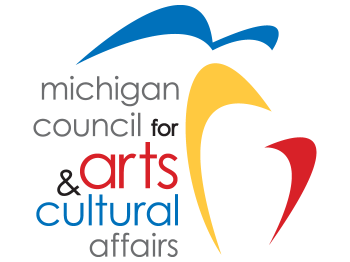A few weeks ago a small outpouring of commentary surfaced with the appearance of three pieces of graffiti portraying former president and Grand Rapids native son, Gerald R. Ford on and around I-196. The most recognized of these portrays Ford as he appeared in a presidential portrait, with the quote "I am indebted to no man" from his inaugural address floating above his head. The other two include a smaller version of the first, while the third portrays a gleeful Ford, bounding across a bright green field in a business suit.
The Michigan Department of Transportation (MDOT) and the City of Grand Rapids were flooded with questions about their take on the graffiti, while in a more public arena the question once again resurfaced: is a well-executed piece of street art considered graffiti or actual art? And part and parcel to that discussion, should the stenciled image of our former president be removed from the freeway and surrounding area?
The City of Grand Rapids makes its stance on graffiti readily available on its website, stating, "When graffiti is allowed to remain, it invites yet more graffiti and may lead to an increase in vandalism and other criminal activity. Rapid removal is considered key to controlling and eradicating graffiti." In an Mlive interview on the topic, MDOT's spokesperson said that in keeping with its policies the images must eventually be removed.
Despite the city's and the MDOT's collective stance on graffiti removal, the images remain and will likely not be painted over for some time, which lends the opportunity for the public discussion of street art/graffiti vs. art to continue throughout the community.
"I love them! I love it when graffiti is well done. I think it takes art, which is generally thought of as something meant for a sort of higher class of consumer, and makes it available at a very public level," answered 25-year-old Lauren VanRheenen, when asked about the images.
"I think they're actually pretty cool. I know this city sort of has a reputation for being clean, but I think there is and always should be a place for that kind of art," added Tim Smith, manager of a local bookstore.
"Even more eye appealing graffiti like the ford [sic] prints still lead to and encourage much less respectful tagging and vandalism and it makes our community less appealing to the masses and as a business owner, in a business district, I want the masses to feel comfortable frequenting my restaurant," says Cory DeMint, owner of the local restaurant The Electric Cheetah.
"People should be honest about what this discussion is really addressing: it's about property. It's about who has the right to make a statement. It's not about art- it's about whose wall it is and whose wall it isn't. It's funny to say that unsanctioned imagery like graffiti will make a cement structure ugly because often in this day and age buildings themselves are not meant to be aesthetically pleasing. Graffiti in this discussion is seen as "low class." The question, as always, is not what is it, but for whom? Who is it for? Who is the art for, and who is the building for?" Kelsey LeBlanc posted when asked about the situation.
In recent years, Grand Rapids has shown an ever-growing appreciation of public art as both an addition to the city's public spaces, as well as in community discourse. With the addition of ArtPrize, it's an appreciation that has attracted not only international attention but international participants. So if Grand Rapids is willing to support public art in certain arenas, it's beneficial for discussions, both public and private, to take place. These discussions should also continue in the community about where the differences between the kind of art demonstrated through this graffiti and that of those pieces invited into the public spectrum by events like ArtPrize really lie.
The Rapidian, a program of the 501(c)3 nonprofit Community Media Center, relies on the community’s support to help cover the cost of training reporters and publishing content.
We need your help.
If each of our readers and content creators who values this community platform help support its creation and maintenance, The Rapidian can continue to educate and facilitate a conversation around issues for years to come.
Please support The Rapidian and make a contribution today.

